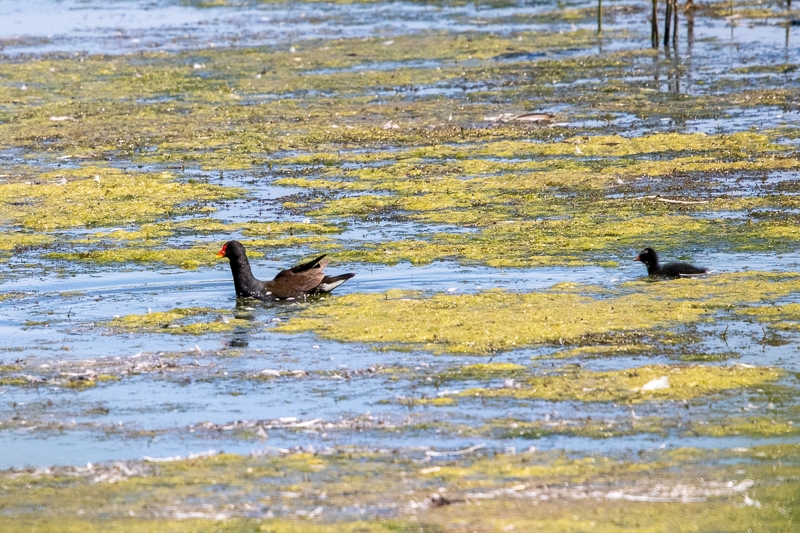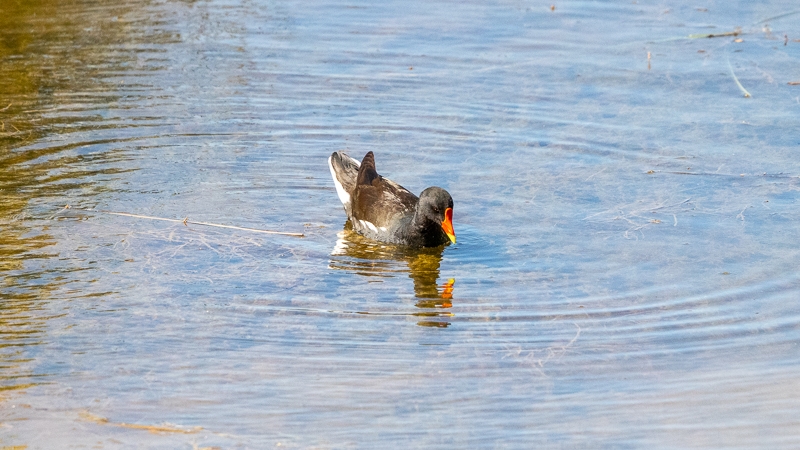MOORHENS NESTING IN TREES?

Walking around the tarn on Ilkley Moor I stopped to admire an extremely fluffy goat willow growing on an island. As I did so, there came an insistent kik-kik-kik from a tree on the bank a little further along the path.
We craned our necks to see who was making the noise and spied a flat, twiggy platform and, just beyond it, a small nest. All I could see through my binoculars was a pointed white bum.
Several minutes passed while we tried to guess who was sitting on the nest. The nest itself looked far too structurally sound to be a wood pigeon nest, but the rump of the bird too big for a songbird or even a jay. I commented that the bird almost looked like a duck, which invited ridicule.
Undue ridicule, it turns out. Eventually, just as it felt like my arms might drop off from holding my binoculars up, she raised her head. A moorhen!
Not quite a duck, but close. Shy waterbirds we usually associate with darting into reeds. Here she was, quite at home in her nest twenty feet in the air.
I was astounded. I knew ducks sometimes nest in hollows in tree trunks but I've never come across a moorhen in a tree canopy. I wondered if she'd been forced to nest up there by the overwhelming number of off-lead dogs that torment the wildlife here day in, day out.
When we got home, I "did the rounds", as I'm fond of saying, which means looking up something interesting in every book I own that might have something to say about it. So what did they have to say about moorhen nesting habits?

Of 11 books that mentioned their nesting habits, five said they nest in trees.
My favourite bird book, called simply Birds and written by J.A.Henderson (year unspecified, fairly old), notes that
'the nest is usually built among rushes beside water, but sometimes on a tree'.
It's odd that the majority of books I checked didn't mention moorhens' fondness of nesting in trees - perhaps it's rare?
A book on eggs and nests from 1910 suggests it is:
'the Moorhen nests among the reeds, rushes, and other waterside vegetation, sometimes on a low-hanging bough, or, in rare cases, high up in a tree.'
The Nature Book of 1913, a sizeable three-volume 'popular description by pen and camera of the delights of the open air', thinks otherwise. It says:
'contrary to what one might think, Moorhens frequently nest in tree or bushes. I have found them at various heights from three to twelve feet from the ground...in such instances the young apparently must be carried down to the water by the parent birds'
a feat I'd dearly love to witness.
Most intriguing of all is a delightful 1920s book called The Pageant of Nature. It's a collection of fascinating insights into the natural world, delivered with an air of wonder. Under '63 - Eccentricity Among Birds' it notes that waterhens
'are prone to take possession of all sorts of strange sites...A waterhen once built a nest in the centre of a large meadow, at least a mile and a half from the nearest water...On the River Crimple, an ivy-covered tree leans over the water, forming at one point a flattish surface, and here a pair of waterhens have built their nest for many years. The only time I knew them miss was when a wild duck fancied the site. When the waterhens began to think about nest-building, they found her already there incubating her eggs. Waterhens are, however, very fond of nesting in trees and bushes. One clump of large rhododendrons on the bank of a lake had three nests in it at one time, and in an adjoining covert was another nest in a fir tree, the branches of which came right down to the ground. The birds used these branches as a ladder, and left well-marked traces where they had hopped from branch to branch to reach the nest.'
Moorhens might love nesting in trees after all.
It's worth noting that the books that fail to mention moorhens' penchant for nesting in trees and bushes are newer than the ones I've quoted above, yet it's clearly still something they do.
The newer books only mention moorhens nesting on water, despite being of a similar size and covering a similar range of topics as the older books.
Maybe it's relevant that the newer books also tend to refer to birds as "it" whereas the older books use "she", "he" and "they". The older books contain reported stories, anecdotes, locations, individual birds as indications of the habits, varieties, personalities, and lives within the species. Newer books tend to talk as if species are a cohesive whole that fits neatly into one of the habitat or nesting habit boxes we've created in recent years.
Personal revelations like this one, that moorhens sometimes nest in trees, are a useful reminder of many things. We don't know everything about the natural world. We sometimes forget what we used to know. Often, we repeat what we've read or heard elsewhere in a restrictive way. Trying to boil species' behaviour down to a neat description usually doesn't give the full picture. Recent nature books might be cold, detached and categorised but the natural world isn't.
Ultimately, life is far more varied and vivid than generally appreciated. Next time you're around water, look up as well as down in search of moorhens.
Share with your friends
Subscribe to learn more
Join me in exploring our natural world and cultural heritage as we learn how to protect and restore it. Get notified on my latest posts and a monthly newsletter on wider conversation topics for us to chat about.
Recent Posts
If you enjoyed this one, then you might like these too.